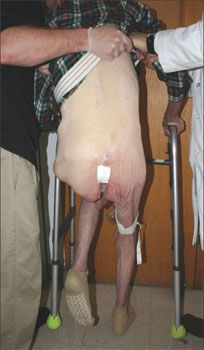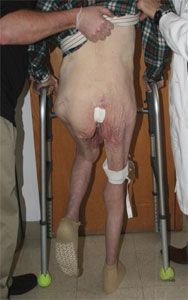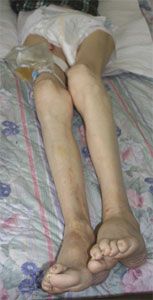- Clinical Technology
- Adult Immunization
- Hepatology
- Pediatric Immunization
- Screening
- Psychiatry
- Allergy
- Women's Health
- Cardiology
- Pediatrics
- Dermatology
- Endocrinology
- Pain Management
- Gastroenterology
- Infectious Disease
- Obesity Medicine
- Rheumatology
- Nephrology
- Neurology
- Pulmonology
An Old Man With a Floppy Bottom
An 88-year-old man who had left hip repair after a fracture a few months earlier is now admitted to behavioral hospital because of implacable refusal to take medications, and because of poor food intake and ongoing refusal of rehabilitation. Ambulated with a walker before fracture but now barely ventures out of wheelchair even with rolling walker and therapist guidance.
This article was originally presented as an independent educational activity under the direction of CME LLC. The ability to receive CME credits has expired. The article is now presented here for your reference. CME LLC is no longer responsible for the presentation of the article.
HISTORY

An 88-year-old man who had left hip repair after a fracture a few months earlier is now admitted to behavioral hospital because of implacable refusal to take medications, and because of poor food intake and ongoing refusal of rehabilitation. Ambulated with a walker before fracture but now barely ventures out of wheelchair even with rolling walker and therapist guidance.
Has long-standing Alzheimer dementia, benign prostatic hyperplasia with urinary retention, and proven, newly reconfirmed chronic urethral catheter dependency despite α-blocker and 5α-reductase inhibitor; urinary tract infection recently treated without incident.
PHYSICAL EXAMINATION
Frail man sitting in a wheelchair. Severe bilateral wasting throughout the lower limbs comprising both cachexia [weight, 105 lb (47.5 kg)] and disuse atrophy. Left leg held in adducted position. Surgical scar well-healed. Muscle stretch reflexes symmetrical. Confused but socially gracious and altruistic. Not hostile or manipulative in talking about his weight and his lack of desire to eat, about which he communicates only that no foods here appeal to him.
WHAT’S YOUR DIAGNOSIS?
ANSWER: TRENDELENBURG SIGN
When this man stands on his intact, unoperated right leg, the left buttock sags sharply, constituting a positive Trendelenburg sign or Trendelenburg test.1-3 The falling buttock reflects failure of right hip abductors to hold the area up and away in the fashion normally employed for balance on 1 leg. The test replicates the swing phase of gait: When the patient lifts the right foot off the ground, the left hip abductors, principally gluteus medius and minimus, contract to keep the pelvis level (Figure 1). However, when he stands on the right and raises the left leg, weak right hip abductors cause the pelvis to tilt downward, and that is the substrate of the fallen buttock (Figure 2). Abductor weakness underlies the adducted rest position of the left leg (Figure 3) but seems counterintuitive; contrary to all reason, abductor weakness makes the opposite buttock fall.


Although his skin is lax from weight loss and generalized muscular atrophy, and although even the unoperated right side shows imperfect power, one discerns that drooping of the buttock on the left side is worse.
A localized, asymmetrical Trendelenburg sign is not a normal sequela of hip surgery, nor of cachexia, sarcopenia, or generalized atrophy of antigravity muscles. We do not see a visible difference in muscle bulk from side to side-the bony landmarks are appallingly exaggerated bilaterally-because overlying tissues obscure any difference. But based on the unilateral Trendelenburg sign we might infer ipsilateral superior gluteal nerve injury, a known complication of hip surgery.4,5
WHY IS THE TRENDELENBURG SIGN HARD TO REMEMBER AND USE?
Besides confusion about having the patient stand on the stronger leg to test the weaker, we become distracted by systematic misspelling of the name Trendelenburg,6 or by his eponymous venous signs and operations, or even by the attachment of his name to a body position once used in shock and for certain operations on the pelvis.
Compounding the chaos, the original description of the sign focused on congenital dislocation of the hip,2 something that the non-orthopaedist today sees seldom and manages still less. Finally, a highly characteristic gait in these patients shared the eponym. It included a compensatory, balance-preserving waddling gait often compared seriously, with no attempt at mockery, to that of a duck.2 In the present patient, the characteristic gait either lay beyond our diagnostic acumen or was absent because upper body weakness precluded the compensatory movements.
WHAT CAN MIMIC THE SIGN OR MASK IT?
Trendelenburg sign reflects hip abductor weakness. Besides congenital dislocation of the hip and superior gluteal neuropathy, such weakness can reflect L5-S1 radiculopathy. It may be most familiar to older physicians from poliomyelitis. A true positive can also occur with infrapelvic abnormalities,5 and in persons with advanced osteoporosis or scoliosis that apposes the rib cage to the iliac brim during testing.1
False positives have been produced by pain, poor balance and, in the challenge (bane?) of geriatrics and of performing this test in small children, by lack of cooperation or understanding of the test method no matter how carefully phrased, demonstrated, or repeated.1
False negatives can result from compensatory maneuvers and trunk positioning whereby patients with neurological disorders tended to move “the torso well over the weight-bearing hip, thereby reducing the amount of abductor activity necessary to maintain this posture . . . [and] by supporting the hand on a table or wall on the non-stance side, they were then able, by a combination of muscle contraction of the shoulder adductors . . . on the non-stance side, with quadratus lumborum on the weight-bearing side, to raise the non-stance side of the pelvis above that of the weight bearing hip,” as Hardcastle and Nade1 elegantly described it.
HOW BEST TO ELICIT THE SIGN?
The classic paper mentioned just above provides detailed guidance: one stands behind the patient and asks that the foot be raised to 30 degrees of hip flexion; if the patient needs to use a cane for support, it must be held on the stance side (that of the weight-bearing hip). Then the patient has to further raise the knee that is already up, and hold it as high as possible for 30 seconds; if need be, the examiner can hold the arm on the stance side, not the other. If nevertheless the patient leans the trunk too far toward the weight-bearing hip, the examiner undoes the compensation by pressing the shoulders to bring the vertebra prominens-that easily felt tip of the C7 spinous process at the root of the neck-back over the weight-bearing hip joint. The same source delineates further detailed interpretation, including of responses that one labels invalid rather than definitively normal or abnormal.1


HOW DO WE INTERPRET WHAT WE SEE HERE?
Interpretation of this sign, even as putatively discerned in works of art, remains challenging and contentious.7,8
The severity of our patient’s background global weakness required external support from both sides, which could falsify the test result.1 Our review of the images, taken before we had read all the literature, suggests that severe truncal tilting did not occur and thus that test interpretation remains valid. If the patient had any tendency to tip the trunk, the positioning of the gait belt countered it (see Figures 1 and 2). We are still stuck with why the sign looks positive when he is standing on the right, not the left: had the surgery damaged the left superior gluteal, it should be the right buttock that sags when he stands on the left leg, precisely the opposite of what we observe.
Like so many other complex frail elders, this patient experienced diverse impediments to neuromuscular integrity and balance over and above deconditioning and nerve injury, eg, foot disorders, venous insufficiency, sarcopenia, the asymmetrical external weighting of a leg bag for urine collection, and the discomfiture of the urethral catheter in addition to a coccygeal pressure sore (Figures 3and 4).
In toto these posed a grave ongoing fall risk; his disinclination to get out of bed offset it at the price of a terribly constricted life space.
Not surprisingly, we saw only modest improvement in strength and assisted gait during his time with us. He was discharged to the long-term care facility where he had lived, with recommendations for continued exercises and close supervision. His will and energy reserves to participate were scant, and personnel to support this highly laborintensive exercising of his muscles would be sparse. We hope he will do better than expected.
Schneiderman H, DePalma AP. Trendelenburg sign in an aged, cachectic, frail man with multiple medical problems. CONSULTANT. 2009;49:325-329.
References:
REFERENCES:
1.
Hardcastle P, Nade S. The significance of the Trendelenburg test.
J Bone Joint Surg Br.
1985;67:741-746.
2.
Trendelenburg F. Trendelenburg’s test: 1895.
Clin Orthop Relat Res.
1998;355:3-7.
3.
Golub BS. The Duchenne-Trendelenburg sign.
Bull Hosp Joint Dis.
1947;8:127-136.
4.
Pai VS. Significance of the Trendelenburg test in total hip arthroplasty. Influence of lateral approaches.
J Arthroplasty.
1996;11:174-179.
5.
Vasudevan PN, Vaidyalingam KV, Nair PB. Can Trendelenburg’s sign be positive if the hip is normal?
J Bone Joint Surg Br.
1997;79:462-466.
6.
Huntley JS. Trendelenburg and not Trendelenberg.
Lancet.
2003;362:174.
7.
Dequeker J. Benign familial hypermobility syndrome and Trendelenburg sign in a painting “The Three Graces” by Peter Paul Rubens (1577-1640).
Ann Rheum Dis.
2001;60:894-895.
8.
Hansen SE. Scoliosis and Trendelenburg sign in a painting by P P Rubens.
Ann Rheum Dis.
2002;61:182.
Acknowledgment:
Matt Schott, Occupational Therapist, worked intensively to diagnose, delineate, document, and overcome this patient’s formidable mobility difficulties.
